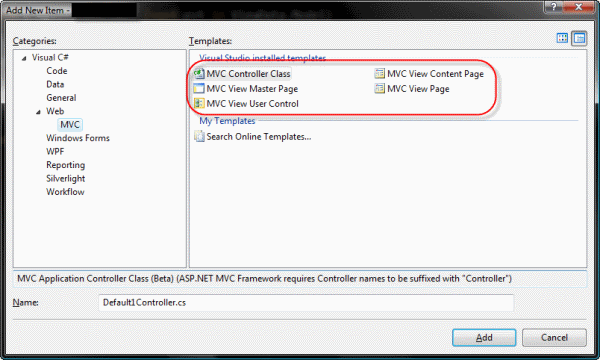Tag: 'asp.net mvc'

If you’re like me, you’ve changed your projects from RC1 to RC2 only to find out that the RTM was coming quickly. Well we are here so we need some steps to convert projects.

Before ASP.NET Core, our world was split between ASP.NET MVC and ASP.NET Web API. In ASP.NET Core that changes to a single model in ASP.NET MVC 6 for handling requests, whether they end up returning data or views.

A while back, I decided that this blog deserved a clean coat of paint and since I’m digging into ASP.NET Core, it was logical to re-write it. I wanted more than just to change the look, I wanted to make some real changes to the code and finally open source the code too!

I had a great time today talking about ASP.NET 5 on a Pluralsight webinar. Over 1,000 people were able to attend. Thank you all for tuning in!

As most of you already know, I have a new course on ASP.NET 5. I’ve just released a teaser video that shows how the Bower.json editor in Visual Studio works.

I want to thank all the great attendees I met at this week’s DEVIntersection (Fall 2015) conference in Vegas! Richard Campbell and company put on a great show!

If you’ve been following along, you know by now that I’m investing my time into learning ASP.NET 5. Now that the ASP.NET team have released a new version, let me help you move your code to the new version.

If you read my blog, you probably already know how excited I am about ASP.NET 5. To dovetail with that, I’ve created a nine-hour course on Pluralsight that covers this brand-new technology from Redmond.

I had planned on finishing these a long time ago, but working on my Pluralsight course about ASP.NET 5 distracted me. Sorry about that.

As I’ve been digging into building apps with ASP.NET 5, I’ve had to get used to some of the new metaphors. Some of these make sense (especially if you’ve used Node before), but some are brand new to me. One of these metaphors I ran into was the idea of Identity notifications.

For my upcoming course, I have a decent sized example that I’ll be teaching from. In the process of watching ASP.NET 5 go through the sprints, I have to upgrade the project at every step. I feel at some point I should be getting better at dealing with the sprints, but not yet ; )

A few weeks back, I released a new course on Pluralsight. This new course talks through what I consider “Best Practices” (though there are no absolutes) for ASP.NET Entities, View Models, and Validation.

NOTE: This post has been updated for changes in Beta 7 and later.

In this second post in my six-part series on ASP.NET 5, we’ll take a look at how your ASP.NET 5 applications will be configured upon startup. The startup in this new version of ASP.NET 5 is very different, but hopefully is clearer and easier to debug. At least that’s my impression so far.

Over the past few weeks I’ve been playing with the new ASP.NET 5 (also known as ASP.NET vNext) bits using Visual Studio 2015. I’m trying to make sense of the new changes and how they will affect how I build websites. I’d like to share some of what I’ve learned about the new stack.

I’ve been working on a new web site wholly using the ASP.NET 5 (e.g. vNext, MVC6, etc.) for the past couple of weeks. This means using Visual Studio 2015 Preview and the new project types in ASP.NET 5.

As many of you know, I am heading out on World Tour this June and heading across Europe and Asia for a year. For the first stop, I’ve partnered with Sparkles to do a training in Belgium this June. If you’re in Europe and you’ve been looking for a way to easily take my web development course, this is your opportunity. We’re only holding it once in Northern Europe.

Are you in the Louisville, KY area this Thursday? I will be! I’ll be at the Louisville .NET Meetup Group talking about Web API..including Web API 2 that was recently released. The details of the event are:

Web API is a pretty sexy REST stack (though others are cool too). As I’ve been talking about it a lot lately, the biggest question by far is authentication and authorization. There are many options including OAuth, Token-based authentication, basic authentication, and even custom solutions. One option that should be included is to use your existing ASP.NET Forms-Based Authentication.

Are you getting ready to build a new website? Are you interested in shortening your development by using Bootstrap, AngularJS, Azure and ASP.NET? If so, my new course might be just for you.

I had a good time doing a couple of talks today. If you joined me online, thanks for coming. For those who missed my talks, they will be posting the videos on Channel 9. As promised you can get the slides and examples here for my talks:

This is the eighth of ten parts of this blog post. The topics will be:

I will be returning to my 10 part series on Modern Web Development soon, but I have a quickie post that hopefully will help some of you.

So as some of you know, I’ve spent a lot of the last year working on a web project. I’ve been using ASP.NET MVC3 and it’s going well. I am at the point where we are creating the mobile apps. I service them, I need an API (which will eventually be available as a public API too). I had started creating using MVC and simple routes but I was urged to look at the new Web API stack that is installed with the new ASP.NET MVC4 installer.

This is the fourth of ten parts of this blog post. The topics will be:

This is the third of ten parts of this blog post. The topics will be:

This is the first of ten parts of this blog post. The topics will be:

In Part 1 of this series, I talked about why I used MVC to create my new venture. In this second part, I will talk about how I implemented MVC.

Url: http://www.codeplex.com/aspnet/Release/ProjectR...

I am working on a hybrid ASP.NET MVC and MVC Dynamic Data project. To work on it I started with the MVC Dynamic Data project assuming this would be a Dynamic Data Project and an MVC project. As Scott Hanselman recently posted, you can mix and match pretty easily so the code was working but I was missing an important piece of functionality in Visual Studio:

